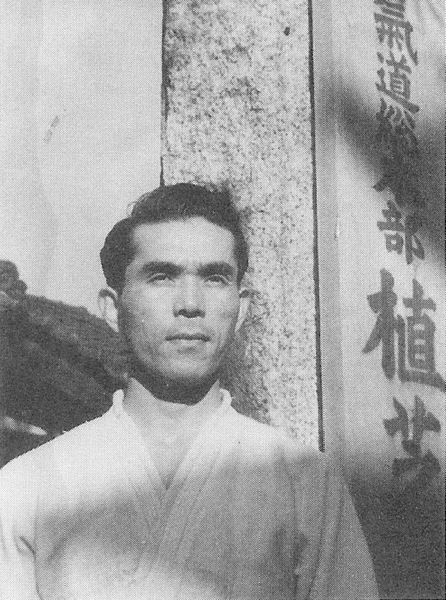 Kanshu Sunadomari (砂泊 諴秀) in front of Ueshiba Dojo – 1954
Kanshu Sunadomari (砂泊 諴秀) in front of Ueshiba Dojo – 1954
Kanshu Sunadomari’s family had close ties to Aikido Founder Morihei Ueshiba through their belief in the Omoto-kyo religion. His older brother, Kanemoto Sunadomari (砂泊兼基), was one of the early students of O-Sensei and the author of the first biography of the Aikido Founder ever published. His sister, Fukiko Sunadomari (砂泊扶妃子), served for many years as the “Fujin Bucho” (婦人部長 / “Head of the Women’s Section”) of the Aikikai.
He became an Uchi-deshi to Aikido Founder Morihei Ueshiba O-Sensei shortly before World War II, and upon his return to Kyushu after the war he gave the first public demonstration of Aikido there in 1953, after which he opened the Manseikan Aikido dojo in Kumamoto. Promoted to 9th Dan by Morihei Ueshiba in 1961, he became independent from the main Aikikai organization after the death of the Founder in 1969. He passed away in November 2010.
Sunadomari Sensei’s book “合気道で悟る” has been published in English as “Enlightenment through Aikido“.
This is the second part of a two part interview that originally appeared in the August 2004 issue of Gekkan Hiden (月刊秘伝 / “Secret Teachings Monthly”), a well known martial arts magazine in Japan. You may wish to read Part 1 of the interview before reading this section.
This interview was also published in a collection of interviews with students of the Founder published in Japanese as 開祖の横顔 (“Profiles of the Founder”) in 2009. There was a short introduction to this work in the article “Morihei Ueshiba – Profiles of the Founder“. A number of English translations of interviews from that collection appeared have appeared previously – Nobuyoshi Tamura Sensei (Part 1 | Part 2), Hiroshi Isoyama Sensei (Part 1 | Part 2), Shigenobu Okumura Sensei (Part 1 | Part 2), Nobuyuki Watanabe Sensei (Part 1 | Part 2), Masatake Fujita Sensei (Part 1 | Part 2) and Yoshimitsu Yamada Sensei (Part 1 | Part 2).
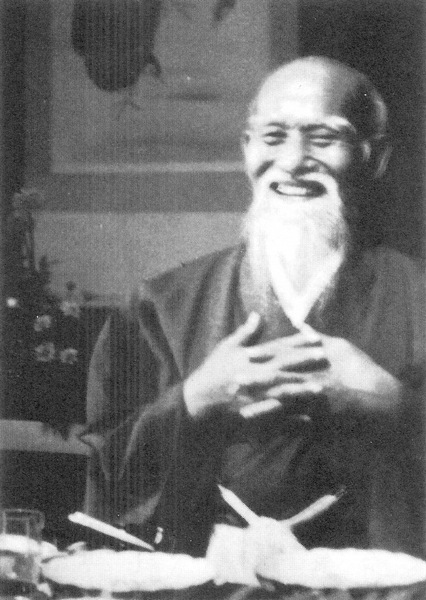 Aikido Founder Morihei Ueshiba O-Sensei
Aikido Founder Morihei Ueshiba O-Sensei
Interview with Aikido Shihan Kanshu Sunadomari – Part 2
Finding the words of the Founder in the midst of struggle.
Q: Rolling up the fingers when applying technique can be called a special characteristic of the current day Manseikan, how did you use your hands when your first started teaching Aikido in Kyushu?
A: They were opened up. It took some twenty years to reach the current form (“maki-komi” / 巻き込み). It didn’t happen all at once, it changed gradually.
Q: Twenty years!
A: It’s not the kind of technique that comes out easily. It started in Showa year 29 (1954) and it finally approached the current form around Showa year 49 (1974). At that time I realized for the first time that the Founder’s words “Aiki is Love” (合気は愛なり) were truly the spirit of Aikido, and began to put the curling of the fingers in the forefront at the dojo and when teaching.
Q: Did you become aware of the importance of the Founder’s words after discovering this curling?
A: Rather than a discovery, it was more that my technique had arrived at that point naturally. So it wasn’t something that I suddenly became able to do. Even now it is still changing little by little.
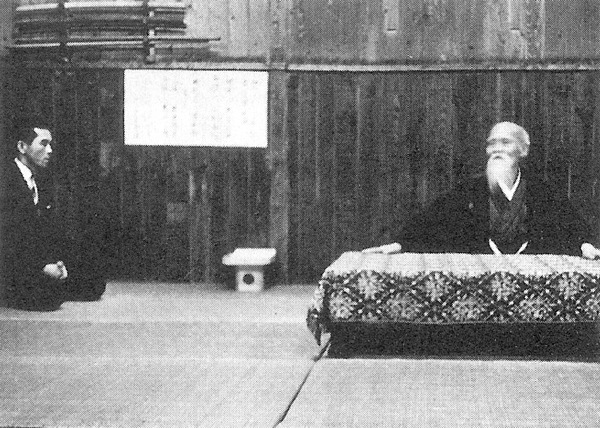 Morihei Ueshiba and Kanshu Sunadomari
Morihei Ueshiba and Kanshu Sunadomari
Q: Your students say the same thing – “Even now Sensei’s techniques are different than they were a year ago”.
A: Those people who take ukemi understand! I myself, who is doing it, can’t really feel it. We have been holding this workshop (Note: this interview was taken on the same day as the workshop) once a month since Showa year 51 (1976) and there are people who come every time. This makes things really difficult. If I just showed Kata then I don’t think that they would come. It’s because I have them take my hand that they are able to feel it. So I think that they become aware of my evolution, and that I will continue to evolve.
Q: But you learned through Kata at first. What I would like to know is how you reached the point where it is no longer Kata. Is it because it wasn’t effective?
A: When I first began to teach Aikido in Kumamoto, people who had trained in other types of Budo began to come to the classes. When that happened they would fight against the techniques and they wouldn’t work. At times like that I couldn’t tell them not to struggle.
Q: I see…
A: There are some dojo where they tell people not to fight against the techniques, but you cannot truly call techniques like that effective. They are okay at the time, but there is no progress and I think that they must eventually hit a wall. Or perhaps, even if they hit that wall they are unaware of it and just continue on doing the same thing.

Morihei Ueshiba at the Manseikan Aikido dojo in 1963
Q: That was a time when Aikido was still unknown, where there many people who wanted to try out their skills against it?
A: Yes, there were. I can talk about it now that it is in the past, but at the beginning I also tried to make the techniques work through Kata and was embarrassed many times. It was because I had that experience that I thought seriously about how the Founder made use of the Mind in techniques.
Q: Do you think that if the opponent is strong then one must also have strength?
A: No matter how a person without physical power attempts to do something physically it won’t work. The world is full of physically powerful people, so there is always a limit. What is important is how we can express the Mind of the Founder in the body. This is not a simple thing. It was a matter of trial and error – I think that someone who only knew me at that time would be shocked to see me in the current day.
Q: When did you actually begin to use the current style of curling the fingers?
A: It was around Showa year 49 (1974) when, somehow, I began to have the feeling that I had become a physical expression of the words of the Founder. As for actually teaching it in a workshop, it was in January of Showa year 51 (1976) when people actually took my hand.

Morihei Ueshiba in Kagoshima – 1961
Q: I have heard that until that time, when you were instructing the police, you would use Atemi when you couldn’t apply your techniques, and that it was through a process of trail and error that you found the clues leading to the “Musubi” that you use now.
A: I think that it was around Showa year 31 or 32 (1961 or 1962), when I first began to teach Aikido in Fukuoka I would do training courses at the police academy. At that time, when my partner came to grab me strongly I would usually apply techniques after first applying an Atemi. I thought “this is no good”. I thought that it was no good if the techniques were ineffective against a resistant opponent, if I couldn’t do anything without applying an Atemi. It was then that I began to reconsider the Mind of the Founder. Even then, I didn’t understand right away! However, my older brother was writing a biography of the Founder, and was slowly collecting the writings of the Founder.
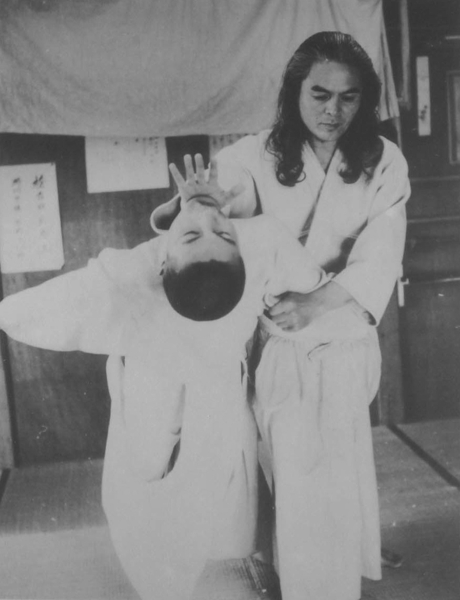
Kanshu Sunadomari’s older brother Kanemoto Sunadomari
from “Aikido Densho” (合気道伝書)
Q: That would be “Aikido Founder Ueshiba Morihei” (合気道開祖植芝盛平 / 1969)?
A: Many of the Gods, and their revelations to him, appear in the writings of the Founder, and the names of the Gods also appear there. The Founder showed these to my older brother so that he could write his biography. They were sent to me after my older brother passed away. Those were my foundation.
Q: What kinds of writings were these?
A: I introduced some of these in my book – one of these is “Aiki is Love ” (合気は愛なり). I trained while thinking about writings of the Founder like this, and the current form (curling fingers) gradually came into being.
Q: It seems that many of those training in Aikido take the path that you have followed as one of their themes. Do you mean that your daily training in the dojo comes to fruition and becomes effective outside of the dojo?
A: I think that you can never understand that as long as you just stay inside the dojo. In the end, you will remain trapped inside the Kata. As long as you are there I think that you will never destroy the Kata.
Q: You must have gone through many struggles in Kyushu to reach the place you are now.
A: The Founder said “Destroy the Kata, create the Kata, Take Musu Aiki is continuous creation and growth”. For that reason, you must destroy the Kata.
Q: But that doesn’t mean to destroy them at random, does it?
A: For that reason the Founder left many writings behind. It is because you shut them away in a drawer and forget about them that there are problems. You have to know how to make the connection from the Mind to the Kata. It’s because you’ve already decided “this is Aikido” that you can’t make that connection.
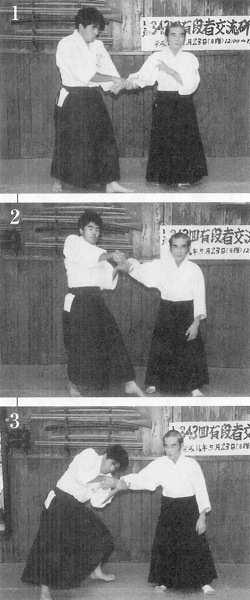
Kanshu Sunadomari exlplains “Musubi”
What is Kokyu-ryoku?
Q: I would like to ask about this again, but what exactly is this “Kokyu-ryoku” that you speak about?
A: Stated simply, it is to entrust the point at which you are engaged to your opponent and become one with them.
Q: Relative to the place in which your opponent is putting in the most strength?
A: Through removing one’s strength one can instantly understand which way their opponent’s power is going, whether they are pushing or pulling. You slip in right there. Later on just being touched by the opponent will cause technique to emerge. When you push with strength you clash with the opponent and it won’t work.
Q: Is the main point of that Manseikan trademark curling the fingers to remove one’s own strength?
A: That’s right. But don’t think that’s all that there is. Technique emerges from many places in the flow of technique. Many, many different techniques emerge from the flow of a single technique. As Ueshiba Sensei said “There are no techniques in Aikido, it is Intent”. He left this written down clearly. For that reason, Kata disappears.
(Translator’s note: The word translated above, and below, in this interview as “Intent” is 魂 (“Hun” / “Kon”), which is often translated as “soul”. Actually, it is one part of the two-souled Chinese cosmology which composes two of the five aspects of consciousness. 魂 is the ethereal soul and is associated with Yo (Yang) and the intellect. According to Zhang Jiebin (1563-1640, whose works formed a major influence on Chinese Traditional Medicine) “The ethereal soul is the coming and going of the mind.”.
Q: Basically speaking, what does it mean to be connected by Kokyu-ryoku?
A: When one takes their partner’s arm their own arm becomes like a rope, joining with the opponent and melting into each other. Here the state of your heart is the problem. It’s absolutely impossible if one has a spirit of antagonism towards their opponent.
Q: So it’s not just a matter of simply releasing your strength?
A: Just removing your strength is no good. One must consciously entrust it to the opponent, little by little. The Founder’s hands were soft, and one did not feel any power!
Q: Isn’t it difficult for the average person to understand the feeling of “entrusting” that point to the opponent?
A: It’s not a movement of the body, here I think that the world of the spirit is important.
Q: Is this the point at which the words of the Founder “Aiki is Love” become relevant?
A: It is necessary to unify the body and the spirit. However, the physical body can’t go ahead. One moves ahead with the spirit as the core. I believe that this is important. I believe that this was left to us by the Founder, and that it was his goal.
Q: Could it be said that the words “Aiki is Love” indicate the state of mind necessary for Kokyu-ryoku, becoming one with the opponent, and realizing the true power of Aikido?
A: The physical body is a vessel for the creation of Intent, and the place of its training. One cannot become conditioned solely through Intent. There is a place for training the physical body, and Intent enhances that.
Q: Like two wheels, one cannot be favored over the other…
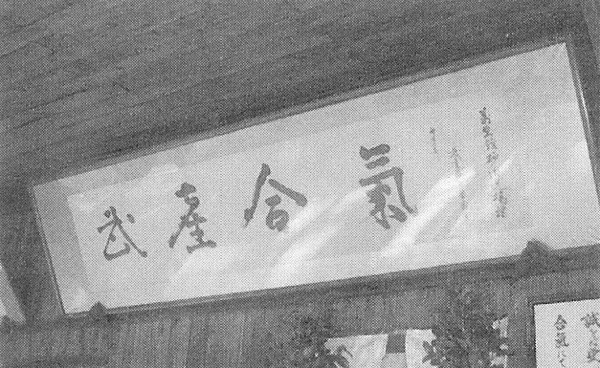
“Takemusu Aiki” calligraphy by Morihei Ueshiba
the inscription reads “The Mother of Takemusu Aiki” (武産合気の母)
Transmitting the Skills of Aiki from the Founder
Q: You weren’t with the Founder for all that long, so why did you come to believe that “everything is contained in the words of the Founder”?
A: Because of their connection to the mentality of the Founder.
Q: It’s not a matter of time?
A: The Founder trained in the Omoto religion, and all of his words came to be through the process of that training.
Q: So, you aren’t just talking about Aikido?
A: In other words, for the Founder Aikido techniques as Budo and religion were the same thing. I believe that it is for this reason that the Budo of the Founder was different from other Budo. I think that the phrase “get rid of the enemy” (敵を無くする) must have come from religion. Because I was raised in religion from the time that I was a child.
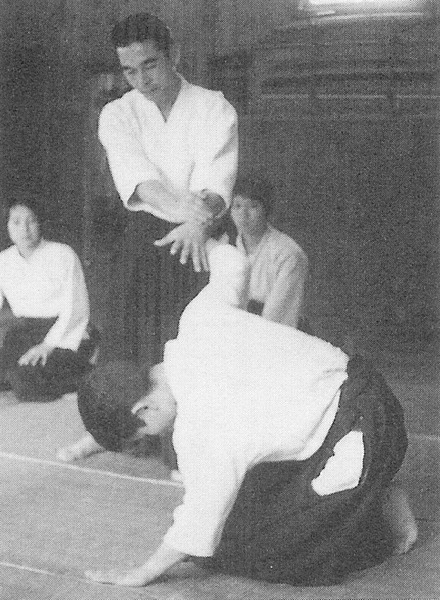
Kanshu Sunadomari at a beginning women’s workshop in 1968
Q: After all, that’s a very important point.
A: There is something there that connects to my spirit. It may be that if that’s not so then one cannot understand.
Q: Somehow we all treat the words “Aiki is Love” as a separate subject from technique, but according to what you are saying the two things cannot be separated as far as Aikido is concerned.
A: Yes, that’s right. I think that this is the reason why the Founder left us the words “What will make World Peace is this Aikido” (世界を平和にするのはこの合気道である) in his writings. If what makes World Peace is Aikido, then the techniques that are appropriate for that path must emerge. Because Aikido is a physical art. However, if one just pursues technique while leaving the words of the Founder incomplete then they will remain mired in the region of Kata. I think that since the Founder was so strong that, even more, the techniques became transmitted as Kata in some ways. In my case I think that it happened naturally. Before the Founder left for Tokyo he said “This Budo will flourish in the Land of Fire” (Note: “Land of Fire” / 火の国 is another name for Kumamoto) – I believe that what I am doing now is what the Founder predicted then. This calligraphy (Note: shown above) was given to me by the Founder in Showa year 36 (1966), can you see there where it says “The Mother of Takemusu Aiki” (武産合気の母)? That is the creator. One senses the connection to Intent.
Q: Speaking of connection, each month at the workshops you have the students take your hand directly.
A: I am turning 81 this year, and of course there are some things that must be transmitted through having them directly take my hand. I’m not just doing this because that’s how we practice every day, this is training in Intent. Although no matter what you do some of your physical power will decrease with age…
Q: You said that it was a smaller group than usual today, but even so you had almost fifty people take your hand, didn’t you?
A: So what that means is that my “forearm” has changed so that it is easier to grasp my “skill” (Note: here Sunadomari Sensei makes a pun on the words for “forearm” and “skill”). Especially since I’ve lost weight as I aged.
Q: So you are transmitting this “skill” (“forearm”)!
A: In the end, even now in my everyday training I think about how to express the words of the Founder in my technique. That is my Shugyo. It is because of this that I do not teach Aikido as Kata. As the Founder said, “There is no Soke in Budo” (武道に宗家がないんだ) – each person training on their own path, walking that path, this is an important state of mind for those learning Budo. In my case, I think that finding how to express the Mind of the Founder in Aikido, and how to spread that to the world has been important. In that sense, it has been one of my goals to create a place where the doors can be opened wide to all people.
Gekkan Hiden Magazine, April 2009
Published by: Christopher Li – Honolulu, HI

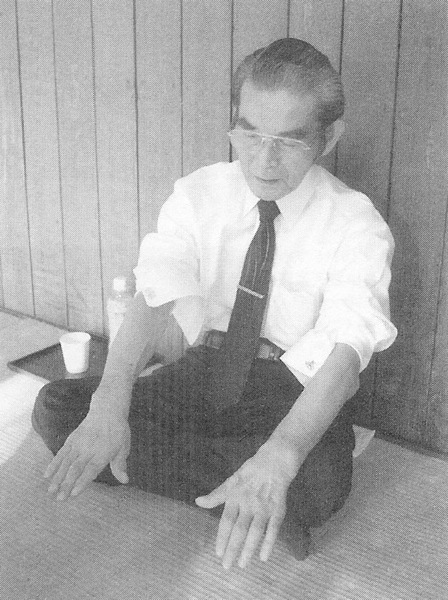


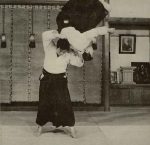


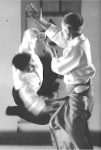
Leave a Reply